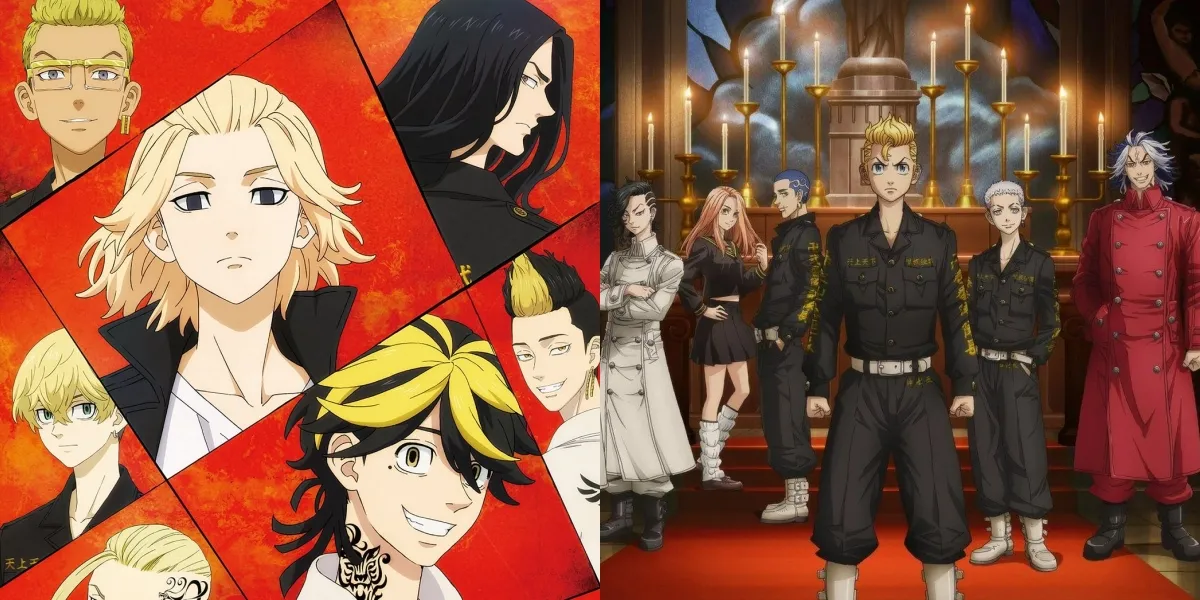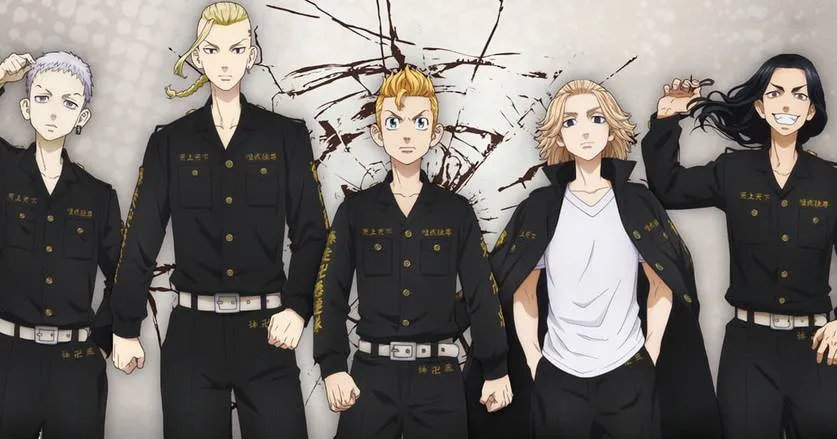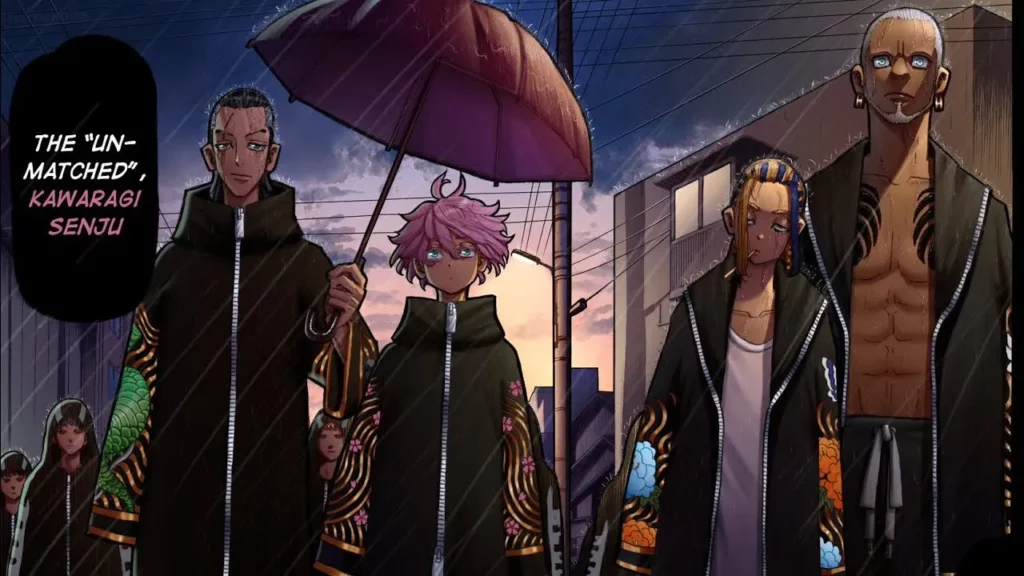Unveiling the Tapestry Of Tokyo Revengers Gangs and Their Names

Introduction
Tokyo Revengers Gangs: Tokyo Revengers, the riveting manga and anime series created by Ken Wakui, thrusts audiences into the heart of Tokyo’s turbulent underworld, where various gangs vie for dominance. The rich tapestry of this narrative is woven with the intricate relationships and conflicts between these gangs, each bearing a name that reflects its unique identity and ideals. We will embark on a comprehensive exploration of all the major gangs in Tokyo Revengers, decoding the significance of their names and unraveling the complexities that shape the series.
1. Tokyo Manji Gang (Toman)

The central force in Tokyo Revengers, the Tokyo Manji Gang, or Toman, stands as a beacon of youthful vigor and resilience. The name “Tokyo Manji” translates to “full of life” or “full of vigor,” encapsulating the boundless energy and vitality of its members. Led by the charismatic Manjiro Sano, known as Mikey, Toman’s name foreshadows the intensity of their presence in the narrative. The emblem, featuring a stylized letter “T,” signifies unity and strength, reinforcing the gang’s identity as a formidable force within the Tokyo underworld.
2. Valhalla

Inspired by Norse mythology, Valhalla represents a gang of warriors who embrace the inevitability of death and find glory in battle. The name refers to the legendary hall in Asgard, where heroic warriors are said to reside after death. Valhalla’s members project an image of fearlessness and honor, embodying the ideals of warriors destined for greatness. Led by the cunning Rindou Haitani, the gang’s emblem, depicting a menacing skull, reinforces their connection to mortality and the cycle of life and death.
3. Black Dragons

The Black Dragons draw inspiration from the real-world Black Dragon Society, a historical ultra-nationalist group in Japan. Their name exudes mystery and power, reflecting a deep-rooted connection to Japan’s history and culture. The dragon, a symbol of strength in various Asian cultures, is fitting for this older, more established gang. The Black Dragons’ rich history and traditions, coupled with their unwavering loyalty, make them a force to be reckoned with. As Toman clashes with the Black Dragons, generational conflicts and ideological differences come to the forefront.
4. Moebius

Moebius introduces a new dimension to Tokyo Revengers, both in name and in the intricate relationships within the gang. Named after the Möbius strip, a mathematical concept with only one side and one boundary, Moebius reflects complexity and interconnectedness. The gang, led by the mysterious Kakucho, challenges the established order, pushing characters to confront the cyclical nature of violence and retribution. The Möbius strip’s symbolism of infinity adds depth to the gang’s identity, emphasizing the ongoing cycle of conflict.
5. Brahman

Brahman is a gang that plays a significant role in Tokyo Revengers, with a name derived from Hinduism, where Brahman represents the ultimate reality. This name suggests a pursuit of transcendence and a higher understanding, hinting at the gang’s motives and ideals. Brahman’s presence introduces a spiritual and philosophical dimension to the series, prompting characters and readers alike to contemplate the deeper meaning of their actions within the context of the gang dynamics.
6. Kanto Manji Gang

The Kanto Manji Gang, a splinter group from Toman, bears a name that signifies its geographical and ideological ties to the original gang. “Kanto” refers to the region in which Tokyo is located, anchoring the gang’s identity to the city. The use of “Manji” in the name establishes a clear connection to Toman, suggesting a shared history and legacy. The emergence of the Kanto Manji Gang adds layers of complexity to the narrative, exploring the impact of internal strife on the broader gang landscape.
Cultural, Historical, and Symbolic Influences
The diversity in the names of Tokyo Revengers gangs reflects a deliberate choice by Ken Wakui to infuse the series with cultural, historical, and symbolic influences. These elements contribute to the richness of the narrative and enhance the overall storytelling experience.
Norse Mythology and Valhalla
The incorporation of Norse mythology in the name Valhalla adds a layer of cultural richness to Tokyo Revengers. The juxtaposition of modern gang warfare with ancient Norse ideals creates a unique atmosphere, exploring themes of destiny, honor, and the inevitability of conflict. The clash between Toman and Valhalla becomes a mythic battle, echoing the timeless struggle between warriors seeking glory and purpose.
Black Dragon Society and the Black Dragons
The nod to the Black Dragon Society adds a historical dimension to the Black Dragons gang. By drawing inspiration from a real-world ultra-nationalist group, Tokyo Revengers intertwines fiction with Japan’s complex history. This connection not only grounds the gang in a historical context but also invites readers to explore the cultural and ideological influences that shape the Black Dragons.
Möbius Strip and Moebius
The choice of the Möbius strip as the namesake for the Moebius gang introduces a mathematical and philosophical layer to Tokyo Revengers. The Möbius strip, with its single surface and boundary, symbolizes interconnectedness and the infinite. This concept becomes a metaphor for the ongoing cycle of violence and retribution within the gang dynamics, elevating the series beyond conventional gang narratives.
Brahman and Spiritual Depth
The inclusion of the name Brahman in Tokyo Revengers introduces a spiritual and philosophical undercurrent. Brahman, representing the ultimate reality in Hinduism, implies a pursuit of transcendence and understanding. This choice deepens the narrative, prompting characters to grapple with existential questions and elevating Tokyo Revengers into a more contemplative and thought-provoking realm.
Conclusion
Tokyo Revengers transcends the typical gang narrative by infusing its gangs with carefully chosen names that carry cultural, historical, and symbolic weight. The series invites readers and viewers to delve into a world where gang conflicts serve as a backdrop for exploring timeless themes such as destiny, honor, and the cyclical nature of human strife. The tapestry of gang names in Tokyo Revengers becomes a reflection of the series’ depth, offering audiences a nuanced and immersive experience that goes beyond the surface-level portrayal of gang dynamics. As the story unfolds, the significance of these names continues to evolve, leaving fans eagerly anticipating each twist and turn in this captivating exploration of Tokyo’s underworld.
Frequently Asked Questions (FAQs)
- Q: What is the central theme of Tokyo Revengers? A: Tokyo Revengers revolves around the themes of gang conflicts, time travel, and the impact of individual choices on the course of history. The narrative explores the complex relationships between various gangs and the protagonist’s quest to change the future through time travel.
- Q: How many major gangs are featured in Tokyo Revengers? A: Tokyo Revengers introduces several major gangs, including the Tokyo Manji Gang (Toman), Valhalla, Black Dragons, Moebius, Brahman, and the Kanto Manji Gang.
- Q: What is the significance of the name “Toman”? A: The name “Toman” is derived from “Tokyo Manji,” which translates to “full of vigor” or “full of life.” It symbolizes the boundless energy and vitality of the gang members, setting the tone for their prominent role in the series.
- Q: How does time travel play a role in the storyline? A: The protagonist, Takemichi Hanagaki, discovers the ability to travel back in time. This unique element allows him to alter the course of history and prevent tragic events, influencing the dynamics of the gangs and their conflicts.
- Q: What cultural and historical influences are present in the gang names? A: The gang names in Tokyo Revengers draw from a variety of influences. Valhalla is inspired by Norse mythology, the Black Dragons have ties to the real-world Black Dragon Society, Moebius references a mathematical concept, and Brahman draws from Hinduism. These influences add depth and layers to the narrative.
- Q: How do the gangs’ emblems contribute to their identity? A: Each gang’s emblem, such as Toman’s stylized “T,” Valhalla’s menacing skull, and the Black Dragons’ dragon symbol, reinforces their identity and values. These emblems serve as visual representations of the gang’s strength, ideology, and legacy.
- Q: What is the role of generational conflicts in Tokyo Revengers? A: Generational conflicts are a recurring theme, particularly seen in clashes between older, established gangs like the Black Dragons and the younger, more rebellious Toman. These conflicts highlight the evolving dynamics within the gang landscape.
- Q: How do Tokyo Revengers explore philosophical and existential themes? A: The inclusion of gangs like Moebius and Brahman introduces philosophical and existential dimensions to the series. The Möbius strip in Moebius symbolizes interconnectedness, while the name Brahman suggests a pursuit of transcendence and understanding, prompting characters to contemplate deeper philosophical questions.
- Q: Can newcomers to anime and manga enjoy Tokyo Revengers? A: Absolutely! Tokyo Revengers has gained popularity among both seasoned anime and manga enthusiasts and newcomers. Its engaging storyline, well-developed characters, and dynamic visuals make it accessible to a broad audience.
- Q: How often do Tokyo Revengers release new chapters or episodes? A: Tokyo Revengers manga chapters are typically released weekly, and the anime series follows a weekly or seasonal release schedule, depending on the production and broadcasting plan.
If you want to know about Tokyo Revengers Arcs, please click on the link.







One Comment